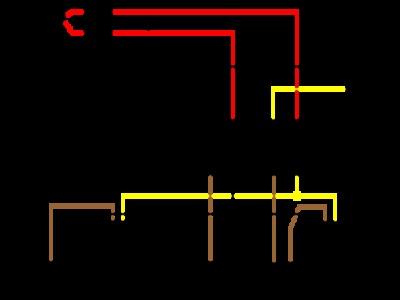I just finished upgrading the headlights on my 74 Road Runner so they run off relays. The parts list was:
- Two 30 AMP Bosch relays ($20 off ebay)
- 12 feet of 12 gauge red wire ($6.99 at Autozone)
- 12 feet of 12 gauge green wire ($6.99 at Autozone)
- 25 feet of 14 gauge white wire ($4.99 at Autozone)
- Four feet of 14 gauge black wire (out of the spares box)
- 10-12 gauge and 14-16 gauge wire connectors (out of the spares box)
- One roll of electrical tape
Before making this modification, read this site: http://www.danielsternlighting.com/tech/relays/relays.html. Most of what I did is spelled out here, but there were some challenges I came across that aren't mentioned on the site.
There are two different relays you can use. One has 87 (headlight power output) and 87a connections and the other has 87 and 87b connections. The 87a connection is open when the 87 connection is closed and closed when the 87 is open. The 87b connection opens and closes with the 87. So if you want to have separate power lines going to the left and right lines, you need relays with the 87 and 87b connectors. You can use the ones with the 87 and 87a connectors, but you'll be running one wire from the 87 connector to both side's lights.
When you order the relays (or buy them at the store), be sure to get plug connectors for them. The relays just have blades on them, and you can connect each wire individually, but the plugs make for a more secure and environment-proof connection, and it looks more professional.
The wiring diagrams for 1974 B bodies show red wire for the high beams and violet for the low beams, but my car had red for the high beams and violet with white stripe for the lows.
As per the Daniel Stern instructions, I also replaced the ground wires. After I did, I found my front marker lights no longer worked since they shared the same ground wire as the headlights. I spliced the ground wires (black) from the marker lights into the new ground wires for the headlights and the markers came back on.
Check all the connections on your alternator when hooking up the main power wires to the relays. I found lots of issues with the wiring to the alternator and their connections, and had to redo those.
I sliced through the old tape on the original headlight wiring harness. There will be four wires in there: red, violet/white, black/yellow, and black. The black/yellow is the power wire for the passenger side marker light, so leave that one alone. The red, violet/white, and black wires can all be removed once you've run the new wiring.
- Two 30 AMP Bosch relays ($20 off ebay)
- 12 feet of 12 gauge red wire ($6.99 at Autozone)
- 12 feet of 12 gauge green wire ($6.99 at Autozone)
- 25 feet of 14 gauge white wire ($4.99 at Autozone)
- Four feet of 14 gauge black wire (out of the spares box)
- 10-12 gauge and 14-16 gauge wire connectors (out of the spares box)
- One roll of electrical tape
Before making this modification, read this site: http://www.danielsternlighting.com/tech/relays/relays.html. Most of what I did is spelled out here, but there were some challenges I came across that aren't mentioned on the site.
There are two different relays you can use. One has 87 (headlight power output) and 87a connections and the other has 87 and 87b connections. The 87a connection is open when the 87 connection is closed and closed when the 87 is open. The 87b connection opens and closes with the 87. So if you want to have separate power lines going to the left and right lines, you need relays with the 87 and 87b connectors. You can use the ones with the 87 and 87a connectors, but you'll be running one wire from the 87 connector to both side's lights.
When you order the relays (or buy them at the store), be sure to get plug connectors for them. The relays just have blades on them, and you can connect each wire individually, but the plugs make for a more secure and environment-proof connection, and it looks more professional.
The wiring diagrams for 1974 B bodies show red wire for the high beams and violet for the low beams, but my car had red for the high beams and violet with white stripe for the lows.
As per the Daniel Stern instructions, I also replaced the ground wires. After I did, I found my front marker lights no longer worked since they shared the same ground wire as the headlights. I spliced the ground wires (black) from the marker lights into the new ground wires for the headlights and the markers came back on.
Check all the connections on your alternator when hooking up the main power wires to the relays. I found lots of issues with the wiring to the alternator and their connections, and had to redo those.
I sliced through the old tape on the original headlight wiring harness. There will be four wires in there: red, violet/white, black/yellow, and black. The black/yellow is the power wire for the passenger side marker light, so leave that one alone. The red, violet/white, and black wires can all be removed once you've run the new wiring.
















